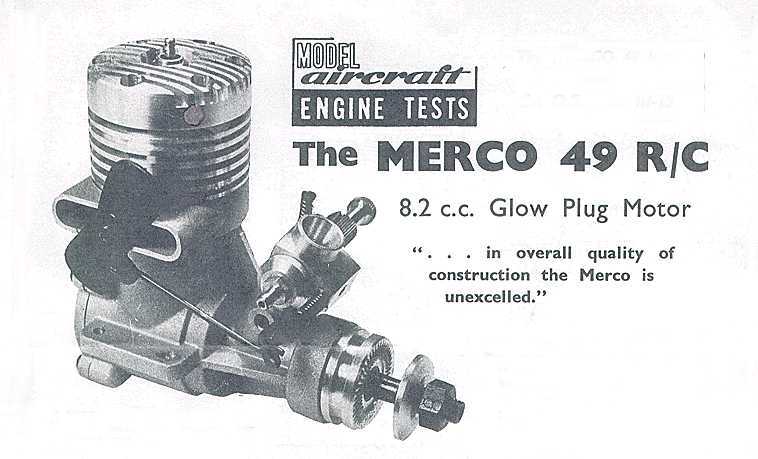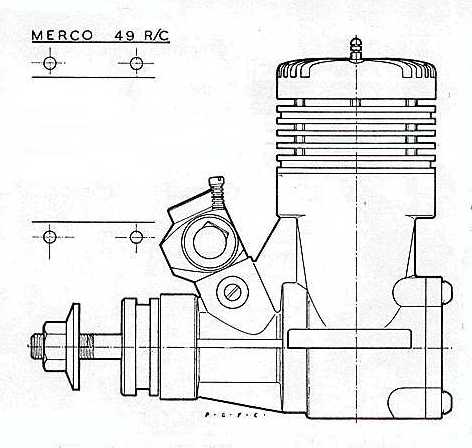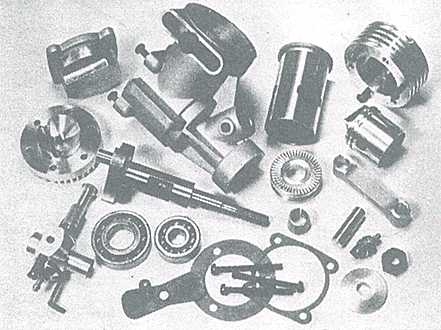Published in 'Model Aircraft' July 1962.


After nearly two years in which outstanding new engines have come thick and fast, but, almost exclusively, from overseas manufacturers, it is a pleasant change to welcome from a English manufacturer a new engine that is truly among the world's best.
At the present time, there are five variable-speed engines available to R/C modellers in the 7.5-8 c.c. class and we have tested all of them. On the basis of these tests, we have no hesitation in saying that, in our opinion, the Merco 49 rates highest of all on an overall performance/quality basis.
For example, it developed the highest peak power output of any of the five engines tested and also proved superior when loaded for lower speeds. Secondly, it was extremely easy to start and, although the other four were also satisfactory in this respect, none was quite so good as the Merco. Thirdly, in overall quality of construction and finish, the Merco is unexcelled. If there is one characteristic in which the Merco does not equal or surpass every other R/C engine, it is, perhaps, its throttle control. Here, we would rate it second to one other 49 previously tested, but, with three points to one in its favour; there would seem to bc every justification for the claim of "world's finest R/C engine" being applied to the Merco 49 at the present time.
Externally, the Merco is a notably is "good-looking" engine. Internally, it is a delight to the eye of the discerning model engine enthusiast. All parts are made from top-quality material, beautifully finished.
Unlike its immediate rivals, the Merco is a ringed engine. The piston is machined from low-expansion aluminium alloy and is fitted with two compression rings specially made by Messrs. Hepworth & Grandage Ltd., manufacturers of full size pistons, rings and cylinder liners. The piston has a flat crown with a nicely filleted baffle and is fitted with a fully floating tubular gudgeon-pin with aluminium end pads. The finely finished cylinder liner has a wall thickness of 0.060 in. and has (as dictated by the use of piston rings) multiple ports which are very well cut and have radiussed corners. Port areas are fairly modest and are located to give exhaust and transfer periods of 130 deg. and 102 deg. (our measurements) respectively, of crank angle. Timing is actually slightly asymmetrical relative to BDC, due to the Desaxe (offset) cylinder arrangement which is common to all the Merco engines. The induction system has an orthodox 45 deg. ABDGC - 45 deg. ATDC timing and involves the use of a 1/2 in. long rectangular shaft port and a 0.385 in. bore gas passage. The carburettor is basically the same as the type originally introduced on the Merco 35 R/C and 29 R/C and features a barrel type throttle rotating around a conventional fixed spraybar with an adjustable air bleed for low-speed mixture compensation. The unit is, however, reversed, to locate the air bleed at the front and in this way, air so taken in is directed close to the spraybar rather than being bypassed below it. Actual choke diameter is the same as for the 29/35 engine. The carburettor plugs mto a substantial boss which is bored 0.370 in. dia. straight into the centre bearing length to form the rotary valve intake aperture. A coupled exhaust baffle is employed to supplement the intake throttle. This is of the simple pivoted blade type used on the 35 and 29, but is pivoted at the centre rather than at one end.
Skefco ball journal bearings' support the crankshaft; a 1/2 X 1 1/8 in. 10-ball race at the rear and an 8 x 22 mm. at the front. These, incidentally, are special quality bearings which S.K.F. approve for speeds of up to 18,000 and 24,000 r.p.m. respectively. The crankshaft itself is very robust and has cutaway web flanks each side of the solid 1/4 in. dia. crankpin to achieve the required degree of counterbalance.
Unlike that of the two smaller Merco engines, the main casting does not include the upper (finned) cylinder section. Instead, a separate cooling barrel is installed between the flange of the cylinder liner and the top face of the casting. Incidentally, a paper gasket is used here to seal the top of the transfer passage and it is worth noting that, should the engine he dismantled at any time, care should be taken to ensure that this gasket is very carefully realigned. There is only about 1/32 in. between the outer edges of the transfer passage and the adjacent tapped holes for the cylinder retaining screws and if the gasket is damaged at this point, a transfer leak can occur.
The closely finned cylinder head is a most elegant machined unit and has a deep hemispherical internal contour which is suitably slotted on the transfer side to clear the piston baffle. It is held down with six Phillips head screws, three of which pass through the cylinder fins and into the main casting.

Type: Desaxe single cylinder, air cooled, loop-scavenged two-stroke cycle, glowplug ignition. Crankshaft type rotary-valve induction. Baffle piston and central ignition plug. Goupled carburettor throttle and exhaust restrictor.
Bore: 0.880 in. Stroke: 0.805 in.
Swept volume: 0.4996 cu. in. - 8.187 cc.
Stroke/Bore ratio: 0.915: 1.
Weight: 12.5 oz.
Pressure diecast L.33 alloy crankcase and main bearing housing with sandblasted finish. Counterbalanced EN.1A steel crankshaft, case hardened, ground and honed and running in two Skefco ball bearings. Cylinder liner of EN.1A steel, case hardened, ground and honed. Piston machined from low-expansion high duty aluminium alloy with reamed gudgeon-pin holes and two Hepolite compression rings. Tubular, fully-floating gudgeon-pin of EN.1A steel, case hardened, ground and honed and fitted with aluminium end pads. Gonnecting rod of forged RR.56 high duty alloy. (Test engine and early production units fitted with machined LM.6 rods.) Gylinder head and cooling barrel machined from high quality duralumin. Metal-to-metal head joint. Pressure diecast L.33 alloy crankcase backplate secured to casting with four screws and paper gasket. Machined alloy prop driver on steel split taper collet. Beam mounting lugs. Separate carburettor unit plugging into intake boss and secured with two grub screws. Barrel type throttle with separate screw adjustments for setting idling speed and low speed mixture strength. Brass sprayhar type needle-valve assembly. Throttle arm on right hand side for direct push-pull coupling to servo and linked to pivoted steel plate exhaust baffle.
Running time prior to test: approximately 3 1/2 hours.
Fuels used: (i) 70 per cent. methanol and 30 per cent, Duokham's Racing Gastor-oil (rurming-in and initial tests). (ii) 70 per cent. methanol, 25 per cent. Duckham's Racing Gastor-oil, 5 per cent. nitromethane (dynamometer and throttle tests).
Ignition plug used: Maker's A-M bar-type long reach plug as supplied.
Fuel system: standard suction feed.
Air temperature: 6o deg. F.
Barometer: 29.6 in. Hg.

Starting the Merco is, as we have said, very easy. We had the test engine started from cold for the very first time within the first two or three flicks of the prop. Warm restarts were virtually first flick without priming or choking, provided fuel was at the jet. This extreme ease of re-starting was obtained with the throttle at practically any opening.
The maker's leaflet states that performance will improve during the first hour's running time but that the required running-in time is at a minimum and suggests that the engine be kept rich until at least 30 min. running time has been accumulated. In fact, our particular engine required rather more running, arid nearly three hours were required before it could be safely leaned out to the optimum performance continuous running setting. It would, however, have been perfectly feasible to "fly" the engine much earlier than this, since the throttle provides a convenient means of introducing a "cooling-off" period should the engine be in danger of overheating - easily detected by a drop in r.p.m. of 200 - 300 after a minute or so of high speed running.
Prior to actual dynamometer tests, a number of checks were made on the available speed range on various props. During the course of these, considerable experiment was made with the throttle adjustments, including re-aligning the factory set-up of the throttle barrel so that the main air intake could be closed off completely with the throttle stop screwed right back. We were able to get r.p.m. right down to 2,000 - 2,300, depending on prop size, but eventually arrived at the conclusion that an idling speed of 2,400 - 2,800 r.p.m. could be regarded as a more realistic figure. It may well be possible, with further experience to operate the Merco at a lower setting under actual flight conditions, but the engine is then getting a trifle sensitive and any one of a number of variables, such as fuel pressure differential with an emptying tank or in manoeuvres, or atmospheric changes, could be responsible for a mid-air stoppage, which risk would not be worth the 300 or 400 r.p.rn. advantage gained.
The power of the Merco is especially apparent when one checks its p erformance on relatively large props. Thus, on a 14 x 6 Top-Flite prop our test motor turned up some 7,700 r.p.m., which was nearly 1,000 r.p.m. better than on an imported 0.45 cu. in. R/C engine tested earlier. On a 13 x 5 1/2 it reached 8,900. A 12 x 6 prop would seem to be a good size for the Merco and appropriate models and a speed of 9,600 was recorded on a 12 x 6 Tornado nylon dropping to a safe 2,400 idle. Further up the scale, 10,500/2,500 r.p.m. were obtained on a 12 x 5 Power-Prop wood, and 11,400/2,650 on an 11 x 5 Top-Flite wood.
Maximum torque developed by the Merco reached 77 oz. in. at approximately 7,000 r.p.m. Equivalent to a b.m.e.p. of 60 lb./sq. in., this is exceptionally good for low nitro fuel. Maximum power reached on test was just over 0.70 b.h.p. at approximately 11,250 r.p.m. which, as we have said, puts the Merco at the top of its class.
Pomx/ Weight Ratio (as tested): 0.90 b.h.p./lb.
Specific Output (as tested) 85.5 b.h.p./litre.

My thanks to Robin Soanes for supplying a copy of this material.